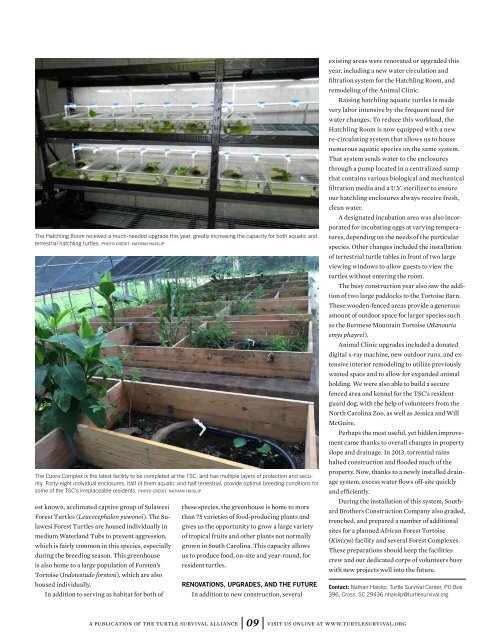Turtle Survival
2tUaeTbNi
2tUaeTbNi
You also want an ePaper? Increase the reach of your titles
YUMPU automatically turns print PDFs into web optimized ePapers that Google loves.
The Hatchling Room received a much-needed upgrade this year, greatly increasing the capacity for both aquatic and<br />
terrestrial hatchling turtles. PHOTO CREDIT: NATHAN HAISLIP<br />
The Cuora Complex is the latest facility to be completed at the TSC, and has multiple layers of protection and security.<br />
Forty-eight individual enclosures, half of them aquatic and half terrestrial, provide optimal breeding conditions for<br />
some of the TSC’s irreplaceable residents. PHOTO CREDIT: NATHAN HAISLIP<br />
est known, acclimated captive group of Sulawesi<br />
Forest <strong>Turtle</strong>s (Leucocephalon yuwonoi). The Sulawesi<br />
Forest <strong>Turtle</strong>s are housed individually in<br />
medium Waterland Tubs to prevent aggression,<br />
which is fairly common in this species, especially<br />
during the breeding season. This greenhouse<br />
is also home to a large population of Forsten’s<br />
Tortoise (Indotestudo forsteni), which are also<br />
housed individually.<br />
In addition to serving as habitat for both of<br />
these species, the greenhouse is home to more<br />
than 75 varieties of food-producing plants and<br />
gives us the opportunity to grow a large variety<br />
of tropical fruits and other plants not normally<br />
grown in South Carolina. This capacity allows<br />
us to produce food, on-site and year-round, for<br />
resident turtles.<br />
RENOVATIONS, UPGRADES, AND THE FUTURE<br />
In addition to new construction, several<br />
existing areas were renovated or upgraded this<br />
year, including a new water circulation and<br />
filtration system for the Hatchling Room, and<br />
remodeling of the Animal Clinic.<br />
Raising hatchling aquatic turtles is made<br />
very labor intensive by the frequent need for<br />
water changes. To reduce this workload, the<br />
Hatchling Room is now equipped with a new<br />
re-circulating system that allows us to house<br />
numerous aquatic species on the same system.<br />
That system sends water to the enclosures<br />
through a pump located in a centralized sump<br />
that contains various biological and mechanical<br />
filtration media and a U.V. sterilizer to ensure<br />
our hatchling enclosures always receive fresh,<br />
clean water.<br />
A designated incubation area was also incorporated<br />
for incubating eggs at varying temperatures,<br />
depending on the needs of the particular<br />
species. Other changes included the installation<br />
of terrestrial turtle tables in front of two large<br />
viewing windows to allow guests to view the<br />
turtles without entering the room.<br />
The busy construction year also saw the addition<br />
of two large paddocks to the Tortoise Barn.<br />
These wooden-fenced areas provide a generous<br />
amount of outdoor space for larger species such<br />
as the Burmese Mountain Tortoise (Manouria<br />
emys phayrei).<br />
Animal Clinic upgrades included a donated<br />
digital x-ray machine, new outdoor runs, and extensive<br />
interior remodeling to utilize previously<br />
wasted space and to allow for expanded animal<br />
holding. We were also able to build a secure<br />
fenced area and kennel for the TSC’s resident<br />
guard dog, with the help of volunteers from the<br />
North Carolina Zoo, as well as Jessica and Will<br />
McGuire.<br />
Perhaps the most useful, yet hidden improvement<br />
came thanks to overall changes in property<br />
slope and drainage. In 2013, torrential rains<br />
halted construction and flooded much of the<br />
property. Now, thanks to a newly installed drainage<br />
system, excess water flows off-site quickly<br />
and efficiently.<br />
During the installation of this system, Southard<br />
Brothers Construction Company also graded,<br />
trenched, and prepared a number of additional<br />
sites for a planned African Forest Tortoise<br />
(Kinixys) facility and several Forest Complexes.<br />
These preparations should keep the facilities<br />
crew and our dedicated corps of volunteers busy<br />
with new projects well into the future.<br />
Contact: Nathan Haislip, <strong>Turtle</strong> <strong>Survival</strong> Center, PO Box<br />
396, Cross, SC 29436 nhaislip@turtlesurvival.org<br />
a publication of the turtle survival alliance 09 visit us online at www.turtlesurvival.org


